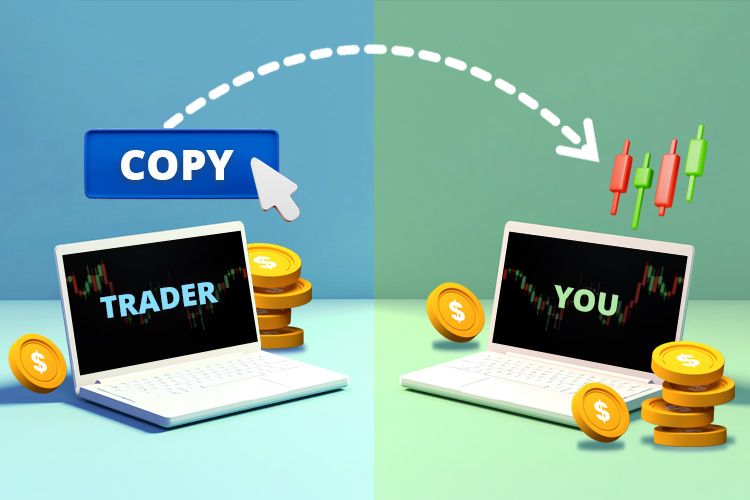Ever wondered how professional traders achieve consistent success? Enter copy trading, a unique approach where you mirror the trades of skilled investors, potentially boosting your returns.

Dreaming of mastering the markets but are short on time or experience? Copy trading might be your answer. This innovative approach allows you to tap into the expertise of top traders, replicating their moves in real time and potentially mirroring their success.
Learn the basics, understand the pros and cons, and discover in this article if copy trading could unlock your hidden trading potential.
What Is Copy Trading?
Copy trading is a subset of social trading, where another trader's account replicates one trader's position in real time. This process can be automated or manual, providing flexibility for individual preferences. This approach allows individuals to mirror the trading decisions of another investor in real time, offering a seamless way to tap into the expertise of the market.
Copy trading simplifies the investment process by enabling you to copy the positions taken by a chosen trader directly. You have the autonomy to determine the amount you wish to invest, and your account will automatically replicate every move made by the selected trader in real time. This ensures that when the trader executes a trade, your account mirrors the same trade, delivering identical returns.
The origins of copy trading can be traced back to 2005, when traders initially copied specific algorithms developed through automated trading. Recognizing its potential, brokers like eToro and ZuluTrade pioneered platforms that allowed traders to seamlessly connect their accounts, eliminating the need for constant monitoring of signals or trading forums.
Copy trading also opens opportunities across diverse markets, including forex, indices, stocks, and commodities. Whether you're eyeing the fast-paced forex market or curious about tech stocks like Apple and Netflix, copy trading provides a straightforward entry without sacrificing intricate technical skills, saving you valuable time.
Trading in and out of different markets becomes easy, allowing you to adjust exposure based on preferences. If you've been itching to trade Apple or explore the intricacies of technology stocks, copy trading simplifies the process.
How Does Copy Trading Work?
The process involves carefully selecting a trader aligned with your goals by considering their followers, profitability, risk level, managed funds, or return on investment. When a trader initiates a position, this information is disseminated across the network, allowing you to replicate the same position manually or through automated systems.
You then choose signals to follow, and every transaction executed is automatically mirrored in your accounts. In return, the signal provider charges you a percentage of the profits, fostering a symbiotic relationship.
Upon selecting a trader, determining the investment amount is crucial for balanced risk management. Diversification is encouraged, distributing funds among multiple chosen traders if needed. The chosen copy trading platform then automatically replicates the selected trader's positions in your account.
Monitoring the performance of the chosen trader is pivotal. If satisfied with their results, traders can consider adjusting their deposit, reducing exposure, or diversifying further by copying additional traders.
Pros and Cons of Copy Trading
Let's delve into the pros and cons of this approach to understand its impact on traders and investors better.
Advantages
- Accessibility: Copy trading opens a user-friendly gateway to the trading arena. Thanks to advancements in social trading networks, this avenue is now readily available to traders.
- Skill Enhancement: Follow the trading activities of seasoned traders, tapping into their years of expertise. Witness their success, replicate their strategies, and develop your trading prowess.
- Flexibility: Maintain control over your risk per trade while mirroring the provider's trades. Adjust trade size proportionally to your account balance.
- Efficiency: Trade alongside top traders even with a busy schedule. Set up and monitor risk parameters for efficient trading.
- Transparency: Compare provider performance on leaderboards, making wins and losses visible.
- Diversification: Use copy trading to align with different traders' strategies.
Risks
- Execution Risk: Like any financial trading, copy trading carries risk if the traded assets are illiquid. Consider factors like bid/offer spread and costs in the copy trader's returns.
- Challenging Selection: Picking the right trader requires thorough research, considering factors beyond monthly returns.
- Additional Costs: Some providers may charge a subscription fee for copying trades.
- Market Risks: Copy trading doesn't shield you from standard market risks like slippage or platform outages.
EndNote
In a nutshell, copy trading offers an easy entry point for individuals looking to benefit from the insights of experienced traders while diversifying their investments. The perks of accessibility, learning from the pros, and the chance to diversify your holdings should be considered alongside the risks associated with market dynamics, potential drawbacks in trader histories, and uncertainties in execution.
Like any trading approach, maintaining a well-informed perspective, conducting due diligence, and prioritizing risk management are crucial for a fruitful and enduring copy trading venture. Lastly, choosing the best copy trading platform is no less important than the other factors.

 Dedicated FREE FOREX VPS
Dedicated FREE FOREX VPS Free FOREX Virtual Private Server
Free FOREX Virtual Private Server MT4 Demo Contest, Get $500
MT4 Demo Contest, Get $500 Sign Up for an Account, Claim 60% Deposit Bonus
Sign Up for an Account, Claim 60% Deposit Bonus Free MT4/MT5 VPS 2024
Free MT4/MT5 VPS 2024 Send E-mail and Get Free Merchandise
Send E-mail and Get Free Merchandise $1K Refer a Friend Bonus for Pepperstone Pro clients
$1K Refer a Friend Bonus for Pepperstone Pro clients Maximize Your Earnings with 100% Deposit bonus
Maximize Your Earnings with 100% Deposit bonus Trade to Win, $5,000 Monthly Demo Contest
Trade to Win, $5,000 Monthly Demo Contest Claim 30% + 15% Deposit Bonus from LiteFinance
Claim 30% + 15% Deposit Bonus from LiteFinance











